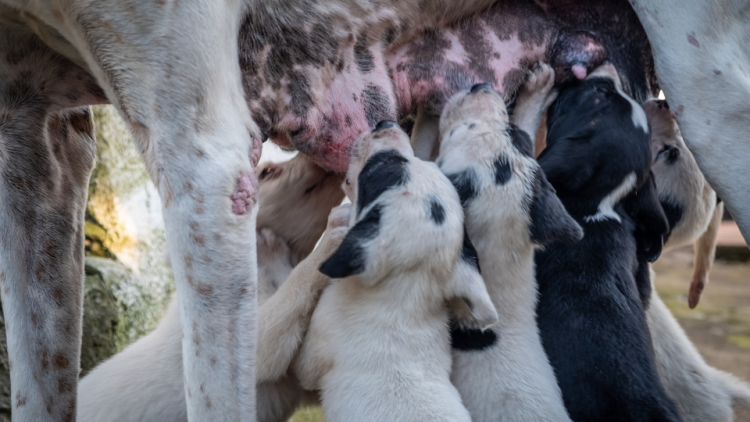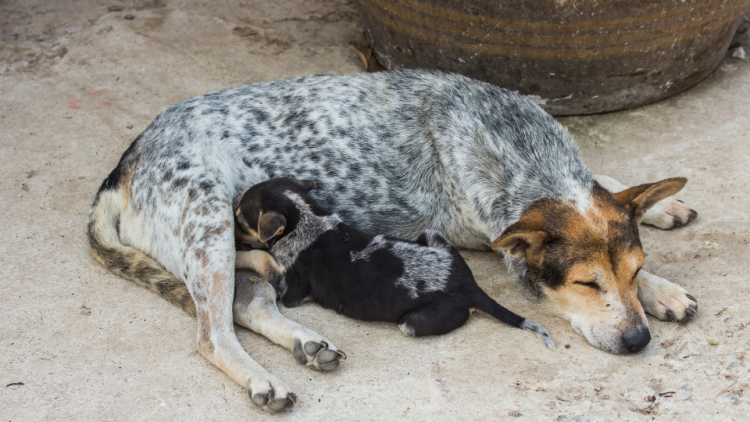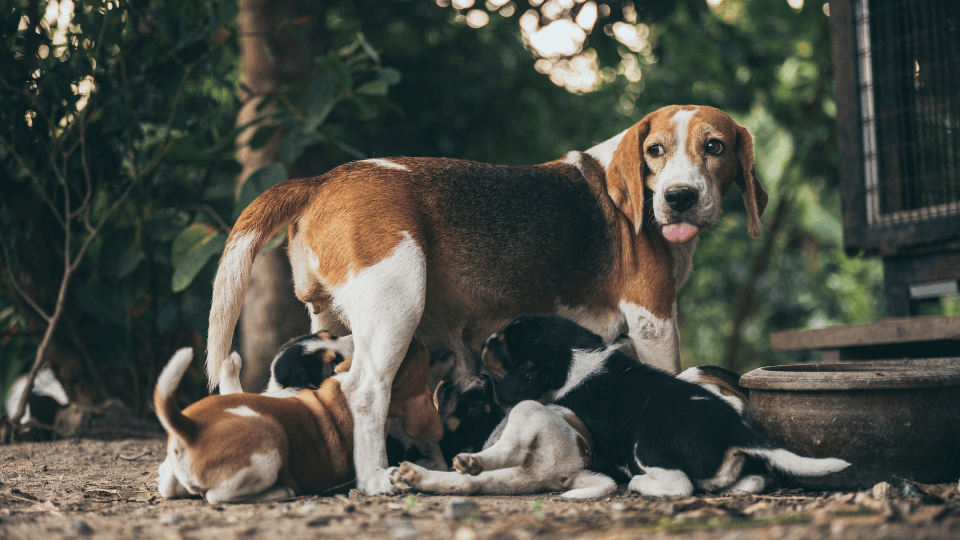Mastitis is a condition most frequently seen in nursing female dogs. It’s quite painful and can progress quickly, putting your pet at risk for infections, tissue damage, and abscess growth.
Knowing the early symptoms of mastitis in dogs can help you make sure that your pet receives timely treatment.
Table of Contents:
- What is mastitis in dogs?
- What causes mastitis in dogs?
- What does mastitis look like in dogs?
- Diagnosing mastitis in dogs
- Mastitis in dogs treatment
- Recovering from mastitis
- Mastitis prevention for dogs
- Key Takeaways
Pro Tip: Whenever you’re concerned about your dog’s wellbeing, a vet visit is in order. Pet insurance can assist in covering the cost of diagnostics, treatment, and ongoing support for health issues that arise after your policy enrollment date.
What is mastitis in dogs?
Mastitis in dogs refers to the inflammation of a canine’s mammary gland (breast), most often caused by a bacterial infection, although fungal infections can also occur. The condition typically affects female animals while nursing as a result of trauma to the nipple. The suckling puppies create cracks and scratches that allow bacteria - such as staph, streptococci, and E.coli - to enter the teat canal and travel up into the mammary gland. Living in unsanitary conditions exposed to parasites and pathogens makes females more prone to developing mastitis in dogs.
What causes mastitis in dogs?
In addition to bacterial or fungal infection, an accumulation of milk built up in the breast can also cause mastitis in dogs. These cases are typically the result of sudden weaning or the death of a puppy. According to American Kennel Club (AKC), the size of the litter doesn’t affect the chances of infection in the mother. However, with larger puppy litters, the teat canals remain open for longer, allowing bacteria to move into the glands more easily. The mammary glands are also more likely to become engorged in dogs with fewer puppies.
Although the condition typically occurs in post-partum females, any dog can develop the condition at any stage in life. This includes male canines, as well as females who are not pregnant or nursing. These instances often indicate a secondary infection from another place in the body, or the inflammation may be a clinical sign of breast cancer, so you should see a vet at first sight of symptoms.

What does mastitis look like in dogs?
Veterinarians categorize mastitis as chronic, acute, or subclinical. In chronic mastitis, the symptoms are more subtle at the beginning and get worse over time. Alternatively, acute mastitis starts suddenly and presents itself with more severe symptoms, such as visibly swollen and painful mammary glands. Subclinical mastitis is often without any symptoms and might only be detected when the puppies don’t grow at a normal rate.
The most common clinical signs in dogs who suffer from mastitis include:
- Painful, firm, and swollen mammary glands
- Discolored breasts
- Red or inflamed teats
- Discharge, blood, or pus from the breasts
- Ulcerated breasts
- Avoiding nursing puppies or growling at them
- Lack of nutrition in the puppies
- Weight loss
- Vomiting
- Dehydration
- Lethargy
- Crying
- Fever
If you notice any of the above-listed symptoms in your pet, be sure to get her to the vet immediately. If left untreated, mastitis can lead to gangrene, septic shock, abscesses, or even become deadly.
Diagnosing mastitis in dogs
Your vet will first inquire about the dog’s health history and the onset of clinical signs. Then, they’ll palpate the dog’s breasts and may take a sample of milk to examine under a microscope for the presence of bacteria or pus (white blood cells). They might also recommend:
- A complete blood count to determine the severity of the infection
- An ultrasound to check for abscesses or tumors
- A thyroid profile to rule out hypothyroidism.
If the mastitis is bacterial and unresponsive to antibiotics, the vet may recommend a bacterial culture test. This can help them determine the most effective antibiotic medications.
Mastitis in dogs treatment
Timely treatment is crucial to stop the mastitis infection from spreading and reduce damage in the dog’s mammary tissue.
In infectious cases of mastitis, the veterinarian will likely prescribe antimicrobial medication. If antibiotics are used, pet parents should pay attention to any reaction their dog or her puppies may have to the drugs. The vet may also prescribe NSAIDs to reduce inflammation and manage pain.
In severely infectious cases, bacteria can enter the bloodstream and cause sepsis. If that’s the case, hospitalization will be required so that the animal can receive IV fluids, antibiotics, and supportive care for several days.
Vets often recommend applying warm compresses and milking out the affected gland several times a day to keep the milk ducts clear. When there are no puppies to nurse, and in cases of pseudopregnancy, hand-milking should be avoided to allow the milk to dry up. In cases like this, the vet might prescribe medication to reduce milk production.
Application of cabbage leaves to the affected breast might reduce inflammation and speed up the swelling.
In rare cases, the infection might cause significant damage to the mammary gland and might require surgery to remove it. Most dogs recover completely from this type of surgery and can continue nursing their pups on the other glands.
Pro Tip: Depending on the severity of the disease, diagnostics and treatment for mastitis in dogs can cost $300 to $800. More severe cases requiring surgery or hospitalization will incur extra costs. Having a pet insurance plan can protect your finances in the event of a surprise illness or accident.

Recovering from mastitis
The prognosis for dogs with mastitis is good. With appropriate treatment, the symptoms usually resolve in two to three weeks.
Acute mastitis requires immediate and aggressive treatment to ensure a full recovery. Your vet will determine the best treatment plan for your dog and schedule follow-up visits to ensure the infection is gone. They will also recommend a proper diet if your dog is still nursing.
However, if the dog isn’t recovering fast enough and can’t care for her puppies, you will need to hand-feed them according to your vet’s instructions. This may be necessary if there’s a concern with the antibiotics she’s using transferring to the pups.
In more severe cases or if a systemic infection occurs, the prognosis is less enthusiastic, even with treatment.
If the mastitis is caused by cancer, your vet will inform you about the treatment options and prognosis. They might also refer you to a specialist.
Mastitis prevention for dogs
The best way to prevent mastitis is by spaying female dogs. Spaying also decreases the risk of developing other conditions like uterine infections and mammary tumors.
When breeding dogs, keep the living area sanitary to reduce the risk of mastitis. Make sure that the whelping box is dry and clean, and change the bedding frequently.
Keeping the mammary glands clean is also crucial in preventing mastitis, as is regular bathing, especially in lactating dogs.
It's wise to clip the puppies’ nails to prevent them from scratching their mother’s skin. Owners should also ensure that all mammary glands are used for nursing to reduce the risk of infection.
Key Takeaways
- Mastitis is an inflammation of the mammary gland. It is a painful condition that can progress quickly.
- Common clinical signs include swelling and redness of the mammary glands, discharge from the nipple, decreased milk production, and more.
- If left untreated, mastitis can cause serious health issues or even result in death. Early detection and treatment are crucial.
- Spaying female dogs is the most reliable way to prevent mastitis
- If you notice symptoms of mastitis in your dog, be sure to contact your vet right away.
